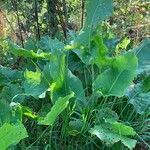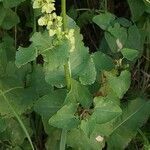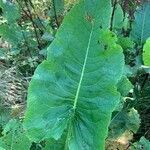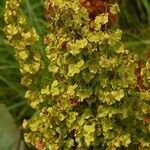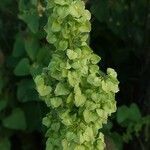Herbs perennial. Stems erect, 40-50 cm tall, branched above, grooved, papillose-pubescent. Basal leaves with petiole longer than leaf blade; leaf blade deeply cordate-triangular, 8-10 × 15-20 cm, slightly longer than wide, abaxially papillate, adaxially glabrous, margin undulate, basal lobes and apex rounded. Inflorescence paniculate, 5-6 × 18-20 cm; rachis flexuous; branches arcuate at base. Flowers bisexual. Pedicel slender, articulate below middle. Inner tepals enlarged in fruit; valves broadly cordate, acutely reniform, 5-6 × 7-8 mm, one valve with a small tubercle, conspicuously net veined, margin with indistinct teeth near base. Fl. May-Jun.
A herb. The stems are erect. It grows 40-50 cm tall.
